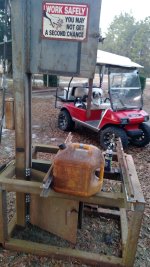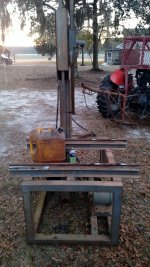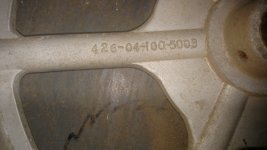Yes, surely the tracking adjuster. Not sure if a flat-faced tire might be for anything but meat. (David angle-slices deer hams to make long, narrow steaks w/bone, and usually frozen first

I never looked at his tires.)
I'd advise crowned tires by far for wood or metal cutting based on much experience with both. (That's where the tracking adjuster works by tilting the wheel, always re-check blade guides) Those I found compatible from Grizzly are urethane vs rubber. Heat 'em, stretch 'em on, slide a round screwdriver etc 360 deg around the rim 'neath each while still warm to 'normalize' stresses in them per instuctions. Look for the proper width and don't worry if the groove is used to keep it centered. Curbs on the wheel are enough if you have them, and I suspect/hope the important rear one on at least is already there.
Also you have what looks like a sliding table, by what appear to be ways 'neath it. (sweet if so) Once you can add/set adjustable-height blade guides you only need one thing for this setup to send a vertical band-saw scurrying with its tail between its legs.
If the table
will slide, I'd attach 90 deg angle-plate into the table (DIY angle widgets can accommodate cuts not at 90 deg) and add an adjustable jaw/screw (jaw face/size need not match, add holes to table for both?) and IMO you'd be able to set up any/all cuts more easily. (coolant could be a mess if saw is not built to be horizontal, I advise mist or MQL if any)
Why I have my preference: Horizontal saws have their own way of adjusting feed/down-pressure. The last one I had daily access to at GM had a hydro cylinder and a valve handle not unlike you'd see on a bottle jack. You'd snug it down first and let up to get the feed rate and/or pressure for the size-shape mat'l you were cutting. (sparkys would visit and not start with a slow feed when cutting their channel. Using the saw would often include changing out for a blade with most of its teeth intact.)
Anyway, if you use the saw as is and take advantage of a sliding table you would always be able to control feed pressure by hand. It wouldn't have to save you blade changes, but save you designing/fabbing something to control feed pressure
and follow your chip when cutting. There's enough difference between sawing 1/4" steel and 1" stuff to matter.btw, We had two verticals in our shop. One had a fixed table, no coolant, and was use for contour cuts. The Do-All vertical did probable > 95% of the work between those two and the horizontal.
Just my :2cents:, but if you have a plan.







